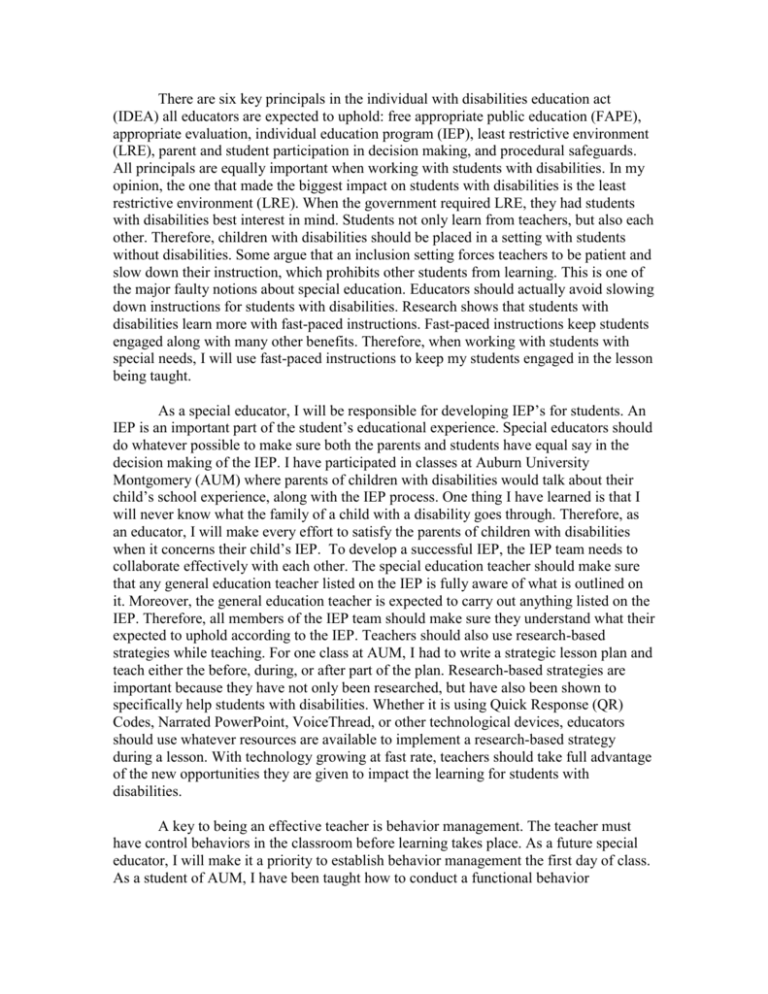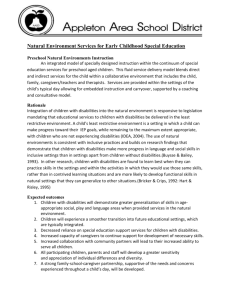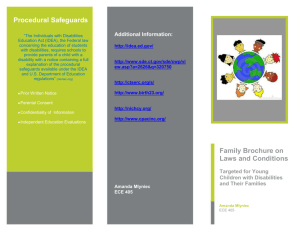ESPE_7914_Philosophy_of_Education
advertisement

There are six key principals in the individual with disabilities education act (IDEA) all educators are expected to uphold: free appropriate public education (FAPE), appropriate evaluation, individual education program (IEP), least restrictive environment (LRE), parent and student participation in decision making, and procedural safeguards. All principals are equally important when working with students with disabilities. In my opinion, the one that made the biggest impact on students with disabilities is the least restrictive environment (LRE). When the government required LRE, they had students with disabilities best interest in mind. Students not only learn from teachers, but also each other. Therefore, children with disabilities should be placed in a setting with students without disabilities. Some argue that an inclusion setting forces teachers to be patient and slow down their instruction, which prohibits other students from learning. This is one of the major faulty notions about special education. Educators should actually avoid slowing down instructions for students with disabilities. Research shows that students with disabilities learn more with fast-paced instructions. Fast-paced instructions keep students engaged along with many other benefits. Therefore, when working with students with special needs, I will use fast-paced instructions to keep my students engaged in the lesson being taught. As a special educator, I will be responsible for developing IEP’s for students. An IEP is an important part of the student’s educational experience. Special educators should do whatever possible to make sure both the parents and students have equal say in the decision making of the IEP. I have participated in classes at Auburn University Montgomery (AUM) where parents of children with disabilities would talk about their child’s school experience, along with the IEP process. One thing I have learned is that I will never know what the family of a child with a disability goes through. Therefore, as an educator, I will make every effort to satisfy the parents of children with disabilities when it concerns their child’s IEP. To develop a successful IEP, the IEP team needs to collaborate effectively with each other. The special education teacher should make sure that any general education teacher listed on the IEP is fully aware of what is outlined on it. Moreover, the general education teacher is expected to carry out anything listed on the IEP. Therefore, all members of the IEP team should make sure they understand what their expected to uphold according to the IEP. Teachers should also use research-based strategies while teaching. For one class at AUM, I had to write a strategic lesson plan and teach either the before, during, or after part of the plan. Research-based strategies are important because they have not only been researched, but have also been shown to specifically help students with disabilities. Whether it is using Quick Response (QR) Codes, Narrated PowerPoint, VoiceThread, or other technological devices, educators should use whatever resources are available to implement a research-based strategy during a lesson. With technology growing at fast rate, teachers should take full advantage of the new opportunities they are given to impact the learning for students with disabilities. A key to being an effective teacher is behavior management. The teacher must have control behaviors in the classroom before learning takes place. As a future special educator, I will make it a priority to establish behavior management the first day of class. As a student of AUM, I have been taught how to conduct a functional behavior assessment (FBA) and write a behavioral intervention plan (BIP). It is important to know how to do a FBA and write BIP when working with kids who will have an emotional behavior disorder (EBD). I will carry out what is on the BIP for students. In addition to my behavior management class, I had to attend 100 hours of conferences in the area of special education. One conference I attended was the APBS international conference on positive behavior support in Atlanta, Georgia. The conference lasted three days and explicitly taught attendees how to use positive behavior support in the classroom. I will take strategies learned from that conference, in addition to my behavior management class, to instill proper behavior in my students. Another great class I have taken at AUM was one that dealt with assessment of exceptional children. For the class I was responsible for conducting a Kaufman Test of Educational Achievement Second Edition (KTEA-II). Though most psychometrist administer the KTEA-II in pubic schools, it was a great learning experience for me. I learned the importance of implementing test to students who are at risk for learning disabilities, intellectual disabilities, etc. After administering the KTEA-II, I was responsible for writing up an assessment report on the student I tested. Again this was great because I had to do multiple things. One tasked involved listing observations I made during the assessment of the student. Therefore, the assessment report held me accountable for paying attention to details of the way students responded to questions throughout the KTEA-II. As an educational specialist candidate, I had to conduct a research project. For my research project, I wanted to combine special education with my past educational background, exercise science. Therefore, I decided to conduct a study that cross-validates body composition methods in individuals with Down syndrome (DS). I chose DS because the population has a prevalence of obesity, in addition to other health concerns. Unfortunately, little research existed on what body composition methods accurate to use for people with DS. After my study was approved, I decided to establish an exercise group for individuals with DS. I currently have 6 individuals with DS who come in twice a week and exercise with me. The best thing about the exercise group is that I can apply what I have been learned at AUM, even though it is in an exercise setting. I have found that a lot of strategies I learned in my special education classes can be used for individuals with disabilities in an exercise setting, with slight modification. One thing I learned in class that has helped my exercise group is chaining and prompting. In the exercise class, there were individuals who had problems with walking on a treadmill. I used forward chaining in addition to physical and verbal prompts to teach them how walk on the treadmill. It was one of the most rewarding experiences I have ever had. Therefore, I really enjoy chaining and prompting and plan to use it in the future.






